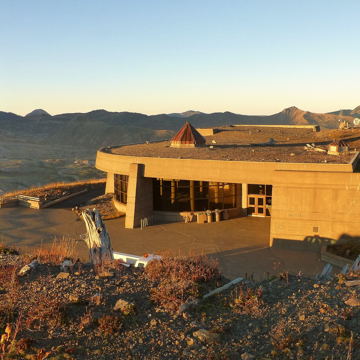The Johnston Ridge Observatory, perched at 4,200 feet in the blast zone of Mount St. Helens National Volcanic Monument, was created through a collaborative process involving a public agency, ecologists, botanists, geologists, interpretation specialists, landscape planners, landscape architects, architects, and structural engineers. The building’s unassuming design was intended to accentuate the visitor’s view—and understanding—of the effects of the powerful 1980 eruption of Mount St. Helens. The observatory is the easternmost of five interpretive, learning, or visitors’ centers along the approximately 52-mile length of the Spirit Lake Highway (State Route 504) which begins at Castle Rock, Washington.
All of the groups and individuals involved in the observatory project understood its seemingly incongruous programmatic needs. The building and master plan had to respond to the disturbed site of blown logs, boulders, sand, and ash, along with the forest community that would replace it in the coming decades. The structure was to blend in with the exposed mountain environment and avoid succumbing to its intense freeze-thaw conditions and strong erosive winds. Members of the planning team wished for outdoor areas to engage diverse visitors while also remaining protected for research about ecological succession—the process by which ecosystems change over time. They hoped the complex would serve to fire the imagination about volcanism and simultaneously commemorate geologist David Johnston, who died while observing the eruption.
The observatory features battered concrete walls and beams containing 17,176 square feet of space that includes a theater and space for exhibits. A structural concrete roof supports an earth cover, and windows open the view towards the massive crater the eruption left behind. The building is tucked into the ridge and the exposed concrete matches the color of the local ash. Given the approximately one-hour drive to the towns and industries lining I-5 to the west, concrete was manufactured on site with a portable batch plant. Prior to the observatory’s construction, the site was thoroughly catalogued so that plants and ejected debris could be returned to their original positions.
Most visitors to Johnston Ridge Observatory arrive by car. After winding beside umber ground, downed trees, and patchy forest regrowth to the road’s end, they arrive at the observatory parking lot. Exiting their vehicles, visitors walk a paved path, wend through a gap in the ridge crest, emerge, and then behold the commanding panorama of the crater, five miles to the south. The observatory, yielding to the landscape, seems subdued and perhaps goes unnoticed. Then gently, slowly, the building is revealed. Upon entering the building, visitors read the exhibits, orient themselves, and eventually find their way into the theater. In the theater, a contemporary video tells the story of the eruption and describes the science “the mountain” inspires. When the movie concludes, the screen rises, and visitors can again gaze at the crater and the volcanic terrain outside, now framed within a wall of windows. Here, the building contains and highlights this landscape, allowing visitors to consider scale, their relationship to this place, and to ponder how landscape disturbance gives rise to renewal.
In the 20-plus years of its existence, the Johnston Ridge Observatory has become a destination that allows visitors to learn about and reflect upon disturbances of all sorts, as well as the particularities of the eruption and its aftereffects. To that end, the building could be interpreted as both heavy and light: heavy with the weight of concrete, memories, and human loss; light in the building’s near invisibility from afar and through its capacity to illuminate understanding about the landscape processes that characterize the Pacific Northwest.
References
“ASLA 2005 Professional Awards.” American Society of Landscape Architects. Accessed November 23, 2015. https://www.asla.org/.
Cantor, Steven L. Contemporary Trends in Landscape Architecture. New York: Van Nostrand Reinhold, 1997.
Rogers, Walter. The Professional Practice of Landscape Architecture: A Complete Guide to Starting and Running Your Own Firm .2nd ed. Hoboken, NJ: Wiley, 2011.
“WACA Award: Cast-in-Place Structures.” Seattle Daily Journal of Commerce, May 15, 1998.
Swanson, Fred. Email interview by author, July 26, 2015 and December 26, 2015.














